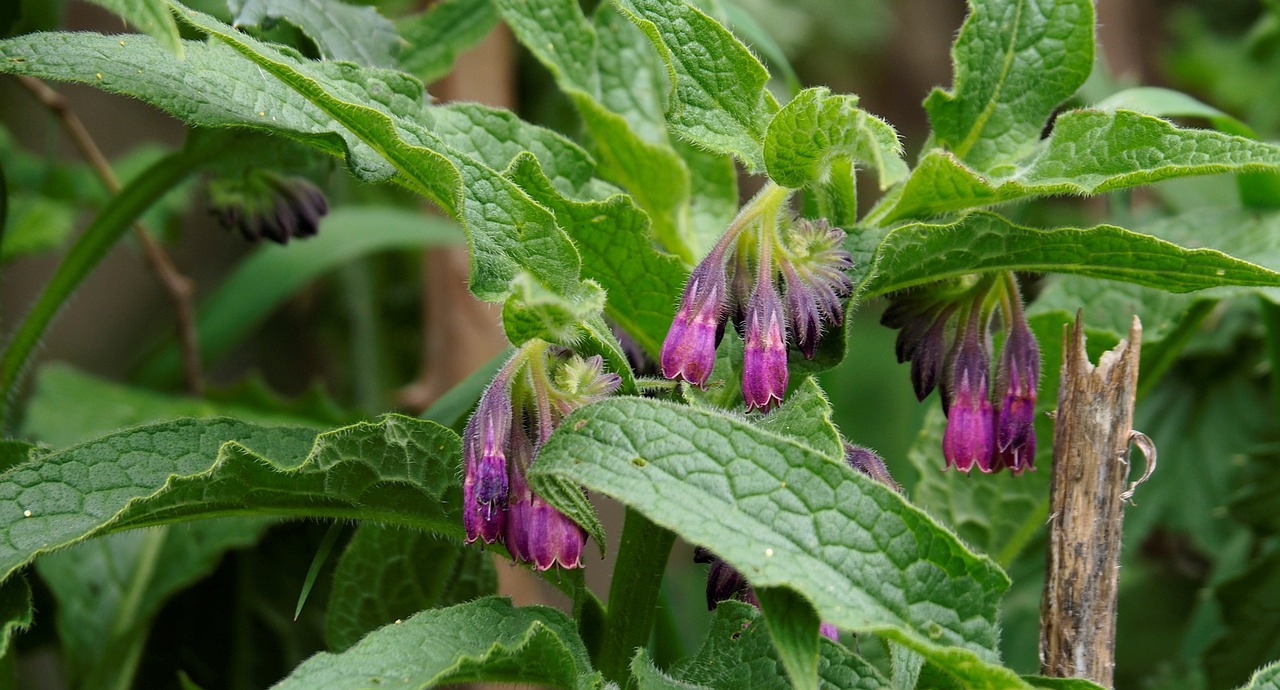
About Comfrey
Comfrey (Symphytum officinale) is a remarkable perennial herb that has long been revered for its medicinal, horticultural, and regenerative benefits. Native to Europe and parts of Asia, comfrey is often recognized by its broad, hairy leaves and clusters of bell-shaped purple, blue, or white flowers. In traditional herbal medicine, comfrey has been used for centuries to treat a variety of ailments, most notably for its ability to heal wounds, reduce inflammation, and promote the repair of bones and tissues. The plant is rich in allantoin, a compound that stimulates cell regeneration, making it a popular ingredient in salves and poultices for treating bruises, sprains, and minor fractures. Additionally, comfrey leaves and roots have been used to make teas and topical treatments that soothe skin irritations and support joint health, although modern herbalists advise against internal use due to potential liver toxicity from its pyrrolizidine alkaloids.
In horticulture and permaculture, comfrey plays a vital role as a dynamic accumulator and nutrient powerhouse. Its deep taproot, which can extend several feet into the soil, allows comfrey to mine essential minerals like potassium, phosphorus, and calcium from the subsoil and bring them to the surface. This makes comfrey an excellent natural fertilizer and soil conditioner when its leaves are used as a mulch or compost activator. Gardeners often plant comfrey near fruit trees and vegetable beds to enhance growth and productivity, as it improves soil fertility and helps retain moisture. Its rapid growth and ability to thrive in diverse conditions make it a perfect choice for creating green mulch that suppresses weeds and builds healthy, living soils. Comfrey’s use as a chop-and-drop plant in permaculture systems is well-established, where its leaves are cut several times a year and left to decompose in place, enriching the soil and nurturing surrounding plants.
In regenerative agriculture and permaculture design, comfrey stands out as a key plant for restoring degraded ecosystems. Its robust root system prevents soil erosion, while its fast-growing nature and high biomass production help sequester carbon and build organic matter in the soil. Comfrey’s nitrogen-fixing ability, though indirect, supports other plants in polycultures and food forests by improving the availability of essential nutrients. In addition to its soil-building properties, comfrey serves as a valuable forage crop for livestock, providing a protein-rich feed that supports healthy animal digestion. Its versatility and ecological benefits make comfrey an indispensable plant in sustainable farming practices, as it contributes to soil regeneration, biodiversity, and resilient landscapes. By integrating comfrey into garden and farm systems, we can harness its powerful regenerative properties to create healthier, more productive ecosystems that align with nature’s cycles.
Here are three common preparations of comfrey, along with their instructions and benefits:
1. Comfrey Healing Salve
Comfrey salve is popular for treating minor wounds, sprains, bruises, and skin irritations due to its high allantoin content, which promotes cell regeneration.
Ingredients:
- 1 cup dried comfrey leaves
- 1 cup olive oil (or other carrier oil)
- 1/4 cup beeswax
- Optional: Essential oils like lavender or tea tree for added healing
Instructions:
- Infuse the oil: Place dried comfrey leaves and olive oil in a jar, then heat gently using a double boiler for 2-4 hours or leave to infuse in a sunny window for 2 weeks.
- Strain the oil through cheesecloth or a fine mesh sieve.
- Melt beeswax in a double boiler and mix with the strained comfrey oil.
- Pour the mixture into small jars or tins and allow it to cool and solidify.
- Store the salve in a cool, dry place, and apply as needed to skin.
Source: “Rosemary Gladstar’s Herbal Recipes for Vibrant Health” by Rosemary Gladstar.
2. Comfrey Compost Tea
Comfrey compost tea is an excellent liquid fertilizer that delivers vital nutrients like potassium, calcium, and phosphorus to plants, improving growth and health.
Ingredients:
- A large bucket with a lid
- 1 part chopped comfrey leaves
- 10 parts water
Instructions:
- Fill the bucket about halfway with chopped comfrey leaves.
- Add enough water to completely cover the leaves.
- Cover the bucket with a lid and let it steep for 3-4 weeks, stirring occasionally. It will develop a strong odor as it ferments.
- Strain the liquid and dilute it with water (1:10 ratio) before applying to plants.
- Use as a foliar feed or soil drench to boost plant health.
Source: “The Permaculture Handbook” by Peter Bane.
3. Comfrey Poultice
A comfrey poultice is used for external application on bruises, sprains, or sore muscles to reduce inflammation and promote faster healing.
Ingredients:
- Fresh comfrey leaves (or dried, rehydrated in warm water)
- Gauze or a clean cloth
Instructions:
- Crush fresh comfrey leaves to release the juices. If using dried leaves, soak them in warm water until soft.
- Apply the mashed leaves directly to the affected area.
- Wrap the area with gauze or cloth to hold the poultice in place.
- Leave it on for 30 minutes to an hour, then remove and clean the area.
- Repeat as needed for pain relief and healing.
Source: “The Complete Herbal Handbook for Farm and Stable” by Juliette de Bairacli Levy.
